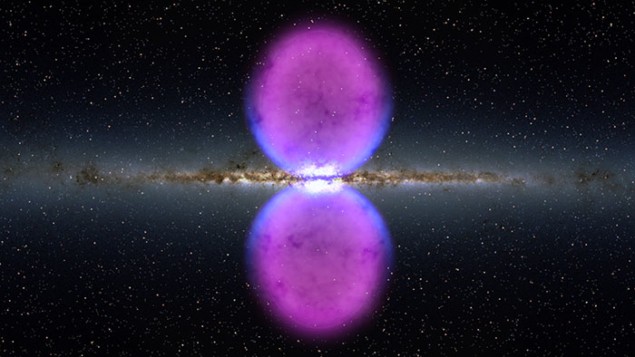
Some types of molecules could form in powerful quasar winds that would ordinarily blast molecules to bits, according to astrophysicists in the US. Their findings, based on computer simulations of the outflows, show that feedback in active galaxies is more complex than had been thought.
Quasars are powered by spiralling discs of gas around a supermassive black hole. The gas in the disc is at billions of degrees and drives powerful winds of radiation that move out into the host galaxy at hundreds of kilometres per second, sweeping up molecular gas that could otherwise be used for star formation.
Under normal circumstances, this molecular gas should be blasted into its atomic constituents by the outflow radiation. However, observations of quasars have revealed unexpected molecular gas, including carbon monoxide, hydroxyl and warm molecular hydrogen, in the outflows. Now Alexander Richings and Claude-André Faucher-Giguère, of Northwestern University, US, think they know how that molecular gas got there.
Chemical simulation
Richings wrote computer code that can model the chemical processes that occur within interstellar gas when it is accelerated by powerful quasar winds. By running simulations based on the code, he and Faucher-Giguère could confirm that any cold molecular gas swept up by the outflows would be heated and ultimately destroyed via photodissociation.
However, they also found that this was not the end of the story. Depending on several factors, including the luminosity of the quasar, the metallicity of the gas swept up in the outflows and the density of the gas, the outflows can cool and allow molecular gas to form once again.
The simulations showed that, at a distance of several hundred parsecs from the quasars (one parsec equals 3.26 light-years), the temperature in the outflows drops below a thousand degrees, allowing warm molecular hydrogen to form. When in an excited state, molecular hydrogen emits in the infrared, thereby removing thermal energy from the outflows and exacerbating their cooling, ultimately permitting other molecules and possibly even stars to form.
Feedback in doubt?
The outflows from quasars are thought to shut down star formation in galaxies by removing their star-forming material in a process called feedback. Does the realization that outflows can create molecular gas mean that the theory of feedback is in doubt?
Not at all, says Richings. When molecular gas forms in the outflow, “it is still moving outwards at a high velocity, which means that it isn’t gravitationally bound to the galaxy itself”, he says. The gas, and any stars that form, will continue to fly out into intergalactic space, leaving behind a dead, sterile galaxy.
In 2017 Helen Russell, from the University of Cambridge, led a team of astronomers to discover cold molecular gas in bubbles blown by an active galaxy at the heart of the Phoenix Cluster, 5.7bn light-years away. Although in the Phoenix Cluster’s case the bubbles are blown by narrow relativistic jets rather than radiative outflows, “molecular formation as considered by Richings is likely important for both radiative and jet-driven molecular winds,” says Russell.
Falling back in
While the radiative outflows remove gas from a galaxy entirely, the jets observed by Russell in the Phoenix Cluster move gas at lower velocities, potentially allowing that gas, and any molecules that may form in it, to fall back onto the galaxy and start forming stars again. “So, in objects like Phoenix, we see a more complex interplay of processes,” she says.
For molecules to form, Richings’ simulations indicate that the level of elements heavier than hydrogen and helium in the outflows must be at least the same level as in the Sun. In the early universe, when black holes were more likely to be active as a result of frequent collisions with other galaxies, gas was not as chemically evolved as it is in large galaxies today and therefore this would hamper the ability of the outflows to form molecular gas.
Blowing Fermi bubbles
Fortunately, we have a much more recent example of an outburst from an active supermassive black hole on our doorstep. The Fermi bubbles, discovered in 2010 by astronomers using NASA’s Fermi gamma-ray space telescope, are two large, radiation-filled cavities climbing above and below the plane of our Milky Way galaxy, and centred on the supermassive black hole at our galaxy’s heart. It is thought that perhaps eight or nine million years ago, the black hole was active for a short time, enough to produce outflows powerful enough to blow out the Fermi bubbles.
“If molecular gas did form in the Fermi bubbles, it might be possible to observe it directly, for example from carbon monoxide emission,” says Richings.
However, it is not yet certain that there will be any molecular gas to be found. Richings simulated the outflows for a duration of a million years and to a distance of just 3260 light-years from the quasar. In comparison the Fermi Bubbles are much larger and older.
“It would be interesting to repeat one of our simulations and follow the outflow for longer to see if we should expect to find molecular gas in the Fermi bubbles today,” he says.
The research is described in Monthly Notices of the Royal Astronomical Society.



